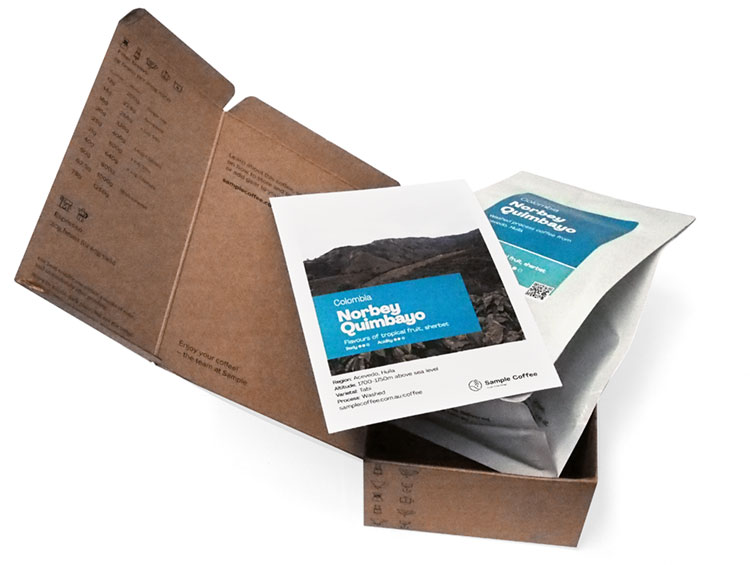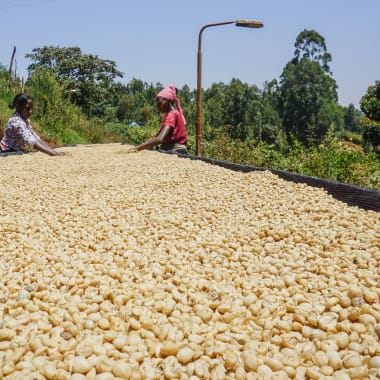-
Producer
-
Esperanza Cabrera
-
Country
- Colombia
-
Region
-
La Florita, Nariño
-
Altitude
-
1950m above sea level
-
Variety
-
Process
-
Harvested
-
May 2016
-
Tasting notes
-
Apple, grape, honeycomb
-
Roast style
Colombia
La Carolina
Thirty-five years ago, Esperanza Cabrera and her husband José Cabrera Burbano started planting coffee seeds on their first farm, Finca Vista Hermosa high up in La Florita, in the Colombian region of Nariño. They also planted a crop of Fique, the material used to make jute coffee bags like the one on this card.
When her husband died, Esperanza and her children continued their work, now split across two farms with the addition of Finca La Carolina, where this coffee was grown. This harvest is the first time that Esperanza has sold her coffee as a micro-lot.
She processes her coffee in the traditional way: washing it, then fermenting it for fifteen hours and then drying in the sun on a patio for eleven days. The area around La Florita is known for its low humidity and cold weather, both of which help slow the drying times and making it easier to maintain the stability of the green coffee.
Esperanza works with the cooperative Café Occidente, which provides agricultural support and helps her find specialty buyers.
The cooperative was founded in 1977 with only fifty members and now has over twenty purchasing points and eight farm supply stores in twelve municipalities for around 1,600 members. Azahar, one of our coffee export partners in Colombia, works with Café Occidente to continue supporting sustainable coffee farms in the area.
We’re proud to support and work alongside them and share Esperanza’s first micro-lot with you as the first Brew Crew in 2017!
Castillo steps out
This is the first time we’ve featured a harvest that’s entirely Castillo. It’s a varietal that we usually see in a mixed lot with Caturra, which is one of the two varietals which were crossed to create this hybrid.
Castillo is a more disease-resistant plant with much higher yields, created by Federación Nacional de Cafeteros de Colombia’s research arm CENICAFE as a hybrid of Caturra and Timor varietals, but which remains similar enough to Caturra to have a the same flavour profile.
Initial suspicions of Colombian farmers following its release in 2005, together with some poor-quality first crops earned Castillo a bad reputation.
Thanks to some very high-quality crops, this reputation is now being challenged, and we’re hopeful that the industry’s desire for flavour-rich, high-quality crops can be met with by a varietal that also gives farmers security against the coffee rust fungus.
The US Speciality Coffee Association has led blind sensory and cupping tests which showed Castillo and Caturra producing similar scores, though with slightly different flavours.
They found that the geographic location and farming techniques had a greater impact on score than the varietal:
For farmers choosing between Castillo and Caturra, what they choose to plant may have less impact on cup quality than where and how they grow it. The data from both the cupping panels at Intelligentsia and the sensory analysis at KSU show that cup scores are more strongly correlated with environment and management than with variety.
In other words, growers may do more to increase cup quality through more active soil and shade management, careful harvesting, and improved post-harvest practices than through the intentional selection of one of these varieties over another.
The farms in the trial that produced exceptional Castillo samples also produced exceptional Caturra samples, meaning that high quality was more a function of where farmers are planting coffee and how they are managing it than which variety they are planting.
Some environments are simply better suited than others to produce high cup quality. The problem is that few growers know whether they are in one of those agroecological niches or not. We commonly use elevation as a proxy for quality potential, but are many other environmental variables that affect the suitability of a particular growing environment for high-quality coffee.
Learn everything about this coffee:
Ethical, traceable sourcing
This page has all the sourcing information (variety, process, region, story, importer, and more) that our importers share with us, and give us permission to use.
The transparency helps us talk confidently about the quality and background of our product, and it helps you know exactly what you’re buying.
Learn more:
Coffee page transparency legend
Our coffee philosophy
Our business approach
Fresh harvest coffee
We only source and roast coffee from each country’s latest harvest season (so the green coffee is never older than 1 year from the time of picking, processing and packing). This ensures the sensory qualities are always at their peak and unaffected by excessive ageing.
Roasted for espresso and filter (best enjoyed black)
Roast style: omni. Omni roasts are designed to brew and taste great both as espresso and filter. Our omni single origins generally sit on Agtron values in the ~70-60 value range. So, technically, they are somewhere in the lighter side of the medium spectrum.
Designed for espresso and filter brewing. Best enjoyed black.
Learn more:
Our Loring Kestrel S35 roaster
Our roasting style and approach
Best brewed within days 15-49 post-roast
The ‘fresh is best’ saying doesn’t apply to coffee (contrary to popular belief). Waiting before opening and brewing your bag of whole coffee beans helps develop peak flavour and acidity.
But heads up: if you buy pre-ground coffee, brew it as soon as possible.
Learn more:
Our recommended brewing window
Try our custom brewing recipes
Our recipes and ratios are tailored to our coffee sourcing and roasting styles, bringing the best flavour and feel out of each coffee.
For pour over, immersion, and other filter brewing styles, check our brew guides.
For our espresso single origins, we recommend a coffee:yield ratio of 1:3:
- Dose: 20g ground coffee
- Yield: 60g espresso
- Total brew time: ~24-28 seconds
This is just a starting point! We encourage you to experiment, taste, and adjust to find the recipe that you enjoy the most.
Learn more:
Our espresso brew guide (single origin)
Brewing ratio calculator
Packaging and sustainability
- Bags: ABA-certified home compostable (AS 5810-2010)
- Labels: recyclable
- Valves (only on +250g bags): general waste
- Box and tape (online orders): recyclable
Learn more:
Our packaging
Variety
Castillo variety
Castillo is named after the researcher Jamie Castillo, who helped develop the varietal in 2005 by Cenicafe, Colombia’s coffee research centre
The location
Coffee from Colombia
Colombia is one of the largest coffee producers in the world and benefits greatly from having one of the most unique and complex set of micro-climates of all coffee producing nations.
The Nariño region of Colombia
One of the highest growing regions in Colombia, producing some truly complex coffees
Farm processes
Washed process
Machines are used to remove the flesh from the coffee cherry before being fermented in water, washed again, and finally sun dried. This process tends to result in more distinct, cleaner flavours.

Subscribe to a world of coffee
Discover a new single origin coffee from Sample every 1-5 weeks with no delivery fees.
No up-front purchase, and you can pause, cancel, or change plans at any time.
Available to order online this week:

Kenya Karindundu Aa
Flavours of orange marmalade, grapefruit, Yunnan red tea
Body Acidity
Washed Batian, SL28, SL34, Ruiru 11
Roasted omni for filter and espresso
Kenya Karindundu Aa online
Ethiopia Girma Sintayehu Honey
Flavours of apricot, mango, coconut, pineapple
Body Acidity
Honey 75227, Wolisho
February 2025 harvest
Roasted omni for filter and espresso
Ethiopia Girma Sintayehu Honey online
Colombia Carlos Imbachi Pink Bourbon
Flavours of pear, jasmine, sugarcane
Body Acidity
Washed Pink Bourbon
February 2025 harvest
Roasted omni for filter and espresso
Colombia Carlos Imbachi Pink Bourbon online
Colombia Jose Elcias Martinez Guzman Pink Bourbon
Flavours of mandarin, burnt orange, pineapple
Body Acidity
Washed Pink Bourbon
December 2024 harvest
Roasted omni for filter and espresso
Colombia Jose Elcias Martinez Guzman Pink Bourbon online